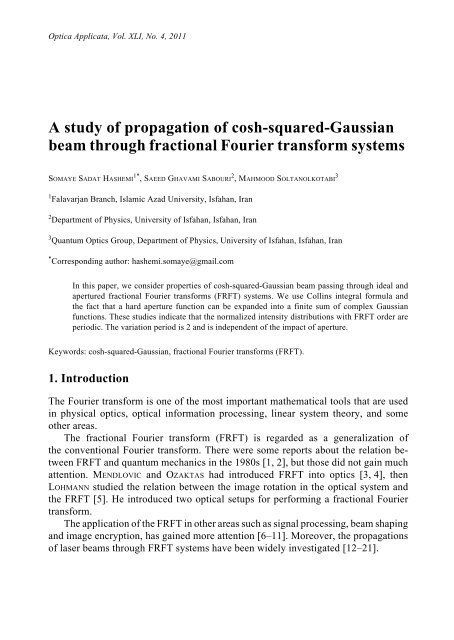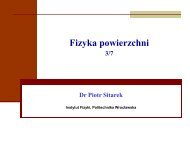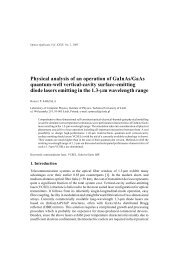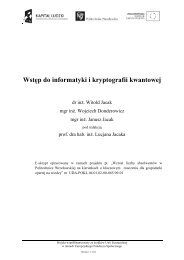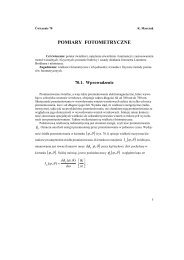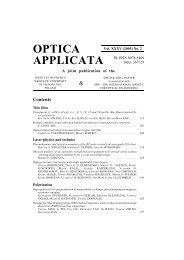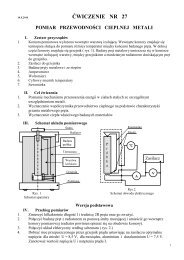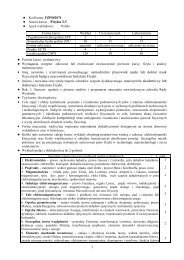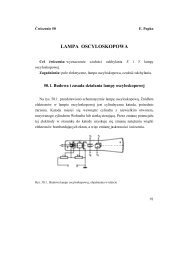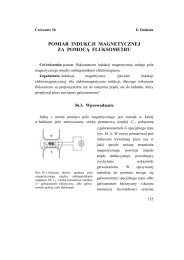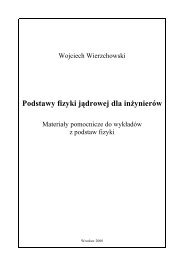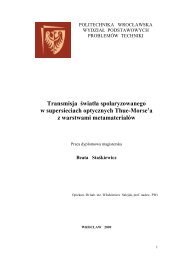A study of propagation of cosh-squared-Gaussian beam through ...
A study of propagation of cosh-squared-Gaussian beam through ...
A study of propagation of cosh-squared-Gaussian beam through ...
You also want an ePaper? Increase the reach of your titles
YUMPU automatically turns print PDFs into web optimized ePapers that Google loves.
Optica Applicata, Vol. XLI, No. 4, 2011<br />
A <strong>study</strong> <strong>of</strong> <strong>propagation</strong> <strong>of</strong> <strong>cosh</strong>-<strong>squared</strong>-<strong>Gaussian</strong><br />
<strong>beam</strong> <strong>through</strong> fractional Fourier transform systems<br />
SOMAYE SADAT HASHEMI 1* , SAEED GHAVAMI SABOURI 2 , MAHMOOD SOLTANOLKOTABI 3<br />
1 Falavarjan Branch, Islamic Azad University, Isfahan, Iran<br />
2 Department <strong>of</strong> Physics, University <strong>of</strong> Isfahan, Isfahan, Iran<br />
3 Quantum Optics Group, Department <strong>of</strong> Physics, University <strong>of</strong> Isfahan, Isfahan, Iran<br />
* Corresponding author: hashemi.somaye@gmail.com<br />
In this paper, we consider properties <strong>of</strong> <strong>cosh</strong>-<strong>squared</strong>-<strong>Gaussian</strong> <strong>beam</strong> passing <strong>through</strong> ideal and<br />
apertured fractional Fourier transforms (FRFT) systems. We use Collins integral formula and<br />
the fact that a hard aperture function can be expanded into a finite sum <strong>of</strong> complex <strong>Gaussian</strong><br />
functions. These studies indicate that the normalized intensity distributions with FRFT order are<br />
periodic. The variation period is 2 and is independent <strong>of</strong> the impact <strong>of</strong> aperture.<br />
Keywords: <strong>cosh</strong>-<strong>squared</strong>-<strong>Gaussian</strong>, fractional Fourier transforms (FRFT).<br />
1. Introduction<br />
The Fourier transform is one <strong>of</strong> the most important mathematical tools that are used<br />
in physical optics, optical information processing, linear system theory, and some<br />
other areas.<br />
The fractional Fourier transform (FRFT) is regarded as a generalization <strong>of</strong><br />
the conventional Fourier transform. There were some reports about the relation between<br />
FRFT and quantum mechanics in the 1980s [1, 2], but those did not gain much<br />
attention. MENDLOVIC and OZAKTAS had introduced FRFT into optics [3, 4], then<br />
LOHMANN studied the relation between the image rotation in the optical system and<br />
the FRFT [5]. He introduced two optical setups for performing a fractional Fourier<br />
transform.<br />
The application <strong>of</strong> the FRFT in other areas such as signal processing, <strong>beam</strong> shaping<br />
and image encryption, has gained more attention [6–11]. Moreover, the <strong>propagation</strong>s<br />
<strong>of</strong> laser <strong>beam</strong>s <strong>through</strong> FRFT systems have been widely investigated [12–21].
898 SOMAYE SADAT HASHEMI et al.<br />
The optical field distributions on FRFT plane can be derived from Collins integral<br />
formula [22]. Although the lenses in FRFT systems are infinite, one can use in real<br />
life apertured lenses or other limited optical instruments. Thus, it is very important<br />
and necessary to consider the hard aperture FRFT systems [23–26].<br />
There are some reports about <strong>beam</strong>s passing <strong>through</strong> apertured FRFT systems<br />
[27–32], and also the effect <strong>of</strong> FRFT order and aperture size on the intensity distribution<br />
for two optical setups <strong>of</strong> Lohmann [27–32]. In these reports, they did not point<br />
out the variation period <strong>of</strong> intensity with FRFT order. However, CHEN et al. have shown<br />
the effect <strong>of</strong> the variation period <strong>of</strong> intensity on the FRFT order [33]. These authors<br />
have used the type I Lohmann system to achieve the FRFT <strong>of</strong> <strong>cosh</strong>-<strong>squared</strong>-<strong>Gaussian</strong><br />
(CSG) <strong>beam</strong>, and they have studied the properties <strong>of</strong> CSG <strong>beam</strong> passing <strong>through</strong> the<br />
ideal and aperture FRFT systems. The characteristics <strong>of</strong> <strong>cosh</strong>-<strong>Gaussian</strong> <strong>beam</strong> have also<br />
been widely studied [21, 34–36].<br />
In this paper, we have investigated the properties <strong>of</strong> CSG <strong>beam</strong> passing <strong>through</strong><br />
the ideal and aperture type II Lohmann system, and we have studied the intensity<br />
distribution <strong>of</strong> CSG <strong>beam</strong> on FRFT plan. To do this, we have used two different<br />
methods, analytical formula and Collins diffraction integral formula. We have implemented<br />
these methods for both Lohmann systems (types I and II) and then have<br />
compared the results.<br />
The paper is organized as follows: the theoretical analyses <strong>of</strong> CSG <strong>beam</strong> passing<br />
<strong>through</strong> ideal and apertured FRFT systems are given in Section 2. The numerical<br />
comparisons using the analytical formulae and the diffraction integral formulae are<br />
given in Section 3. Finally, our conclusion is given in Section 4.<br />
2. Field distribution calculation for ideal and analytical cases<br />
Let us consider the case <strong>of</strong> an infinite size <strong>of</strong> lenses in FRFT systems and Lohmann<br />
systems as illustrated in Fig. 1. We have used type II Lohmann system, as shown in<br />
Fig. 1b, where f s is the standard focal length, p is the FRFT order, φ = pπ/2, d is<br />
the distance between the input (z = 0) and output (z = d) planes.<br />
Input<br />
plane<br />
d = f s tan(φ/2)<br />
f = f s /sinφ<br />
d = f s tan(φ/2)<br />
Output<br />
plane<br />
Fig. 1. Lohmann optical systems: type I (a), and type II (b).<br />
a f = fs/tan(φ/2) b<br />
d = f s sinφ<br />
z = 0 z = d
A <strong>study</strong> <strong>of</strong> <strong>propagation</strong> <strong>of</strong> <strong>cosh</strong>-<strong>squared</strong>-<strong>Gaussian</strong> <strong>beam</strong>... 899<br />
I/I max<br />
1.0<br />
0.8<br />
0.6<br />
0.4<br />
0.2<br />
0.0 –10 –5 0 5 10<br />
It is known that the optical field distribution <strong>of</strong> the one-dimensional <strong>cosh</strong>-<strong>squared</strong>-<br />
-<strong>Gaussian</strong> <strong>beam</strong>s on the input plane is characterized by [33, 36]:<br />
E0( x0) =<br />
x 0 [mm]<br />
2<br />
⎛ x0 ⎞ 2<br />
exp⎜–<br />
----------- ⎟<strong>cosh</strong><br />
( Ω x0)<br />
2<br />
⎝ w ⎠<br />
0<br />
Ω = 0<br />
Ω = 0.5<br />
Ω = 0.7<br />
Ω = 0.9<br />
Ω = 1.0<br />
Fig. 2. Normalized intensity for different Ω ’s on input plane (w 0 = 2.5 mm).<br />
where w 0 represents the <strong>beam</strong> waist <strong>of</strong> <strong>Gaussian</strong> <strong>beam</strong>, Ω is the parameter associated<br />
with the <strong>cosh</strong> part, and x 0 is the transversal position on the plane z = 0. By changing<br />
the value <strong>of</strong> Ω, one gets different optical field distributions (Fig. 2). For Ω =0, Eq.(1)<br />
denotes the usual <strong>Gaussian</strong> <strong>beam</strong>.<br />
To achieve the optical field distributions on FRFT plane we have use the Collins<br />
integral formula [22]:<br />
Ex ( )<br />
=<br />
∞<br />
i<br />
– ------------ E0( x0) i<br />
λB<br />
π<br />
------------ ⎛ 2 2<br />
Ax0 + Dx – 2xx ⎞<br />
∫ exp – 0 dx<br />
λB ⎝ ⎠ 0<br />
– ∞<br />
The constant phase in Collins formula, which has no influence on the output<br />
intensity distribution has been omitted. A, B, and D are the elements <strong>of</strong> the system<br />
transfer matrix.<br />
If the lenses <strong>of</strong> type II Lohmann system are infinite, the transfer matrix from<br />
the plane at z =0 to plane z = d becomes:<br />
d<br />
1 – --------- d<br />
f<br />
M<br />
d<br />
f 2<br />
= =<br />
2<br />
------------ – --------d<br />
1 – --------f<br />
f<br />
cosφ fs sinφ<br />
1<br />
– -------- sinφ<br />
cosφ<br />
f s<br />
(1)<br />
(2)<br />
(3)
900 SOMAYE SADAT HASHEMI et al.<br />
By substituting relations (3) and (1) into relation (2), and performing the integration<br />
we obtain the optical field distribution on FRFT plane<br />
Eideal( x)<br />
=<br />
2<br />
iπw 0<br />
– ----------------------------------------------------------------<br />
2<br />
4( λ fssinφ + iπw 0 cosφ<br />
)<br />
( πxw0) 2<br />
iπx<br />
– -----------------------------------------------------------------------------------<br />
2<br />
λ fs sinφλf<br />
( ssinφ + iπw 0 cosφ<br />
)<br />
2<br />
cosφ<br />
× exp<br />
– ---------------------------λ<br />
fs sinφ<br />
Ω<br />
1<br />
(4)<br />
From relation (4) we see that the optical field distribution on FRFT plane in addition<br />
to the <strong>beam</strong> parameters depends on the system parameters such as the standard focal<br />
length fs and FRFT order p.<br />
It is worth mentioning that the transfer matrixes for types I and II Lohmann systems,<br />
in the case <strong>of</strong> an infinite size <strong>of</strong> lenses, are equal. In other words, the ideal optical field<br />
distribution for both Lohmann systems are identical. In this case, we have obtained<br />
the same distribution <strong>of</strong> the ideal field on FRFT plane for both Lohmann systems. Our<br />
results are for type I Lohmann system the same as given in Ref. [33].<br />
Usually, the lens in FRFT system is finite and an aperture is to be added in<br />
the calculation. We consider two apertures, one in front <strong>of</strong> the input lens and the other<br />
on the output lens. The second aperture only truncates the output field distribution.<br />
According to the Collins diffraction integral formula the approximate analytical<br />
expression for the output field distribution <strong>of</strong> a CSG in the FRFT plane is derived as<br />
follows:<br />
2 ⎛ 2<br />
w0 λ fs sinφ<br />
⎞ ⎛ 2<br />
⎜-------------------------------------------------------- ⎟<br />
2πiw0Ω x ⎞<br />
× + exp<br />
<strong>cosh</strong>⎜--------------------------------------------------------<br />
⎟<br />
⎜ 2 ⎟ ⎜ 2 ⎟<br />
⎝ λ fssinφ + iπw 0 cosφ<br />
⎠ ⎝ λ fssinφ + iπw 0 cosφ<br />
⎠<br />
Eapertured( x)<br />
=<br />
where a denotes the half-width <strong>of</strong> the lens aperture, defined by the hard aperture<br />
function as:<br />
tx ( )<br />
=<br />
⎧ 1, x ≤ a<br />
⎨<br />
⎩ 0, x > a<br />
In this case, the relation (5) becomes<br />
Eapertured( x)<br />
=<br />
a<br />
×<br />
i<br />
– ------------ E0( x0) i<br />
λB<br />
π<br />
------------ ⎛ 2 2<br />
Ax0 + Dx – 2xx ⎞<br />
∫ exp – 0 dx<br />
λB ⎝ ⎠ 0<br />
– a<br />
∞<br />
i<br />
– ------------ tx ( 0)E(<br />
x<br />
λB<br />
0 0)<br />
i<br />
(7)<br />
π<br />
------------ ⎛ 2 2<br />
Ax0 + Dx – 2xx ⎞<br />
∫<br />
exp – 0 dx<br />
λB ⎝ ⎠ 0<br />
– ∞<br />
×<br />
(5)<br />
(6)
A <strong>study</strong> <strong>of</strong> <strong>propagation</strong> <strong>of</strong> <strong>cosh</strong>-<strong>squared</strong>-<strong>Gaussian</strong> <strong>beam</strong>... 901<br />
In order to calculate the integral we should select a form <strong>of</strong> hard aperture function<br />
introduced in many references [23–26]. We use one given in Ref. [24]:<br />
tx ( ) An (8)<br />
a<br />
where An and Bn are the expansion and <strong>Gaussian</strong> coefficients, respectively, which can<br />
be obtained directly from computation <strong>of</strong> relations [25, 26].<br />
By substituting relations (1), (3), and (8) into relation (7), and performing tedious<br />
integration:<br />
2<br />
----------- x 2<br />
N ⎛ ⎞<br />
= ∑ exp⎜–<br />
⎟<br />
n = 1 ⎝ ⎠<br />
x<br />
(9)<br />
an approximate analytical expression for the output field distribution in the FRFT plane<br />
is obtained:<br />
2n<br />
α x 2<br />
∞<br />
⎛– – 2βx⎞ ∫ exp<br />
dx<br />
⎝ ⎠<br />
– ∞<br />
⎛ β<br />
– --------- ⎞<br />
⎝ α ⎠<br />
2n π β-------α<br />
2<br />
⎛ ⎞ ( 2n)!<br />
α<br />
⎜---------- ⎟ ---------------------------------<br />
⎝ α ⎠ l! ( 2n– 2l)!<br />
4β 2<br />
⎛ ⎞<br />
⎜-------------- ⎟<br />
⎝ ⎠<br />
l<br />
=<br />
n<br />
exp ∑<br />
l = 0<br />
where<br />
Ex ( ) = An n = 1<br />
×<br />
N<br />
∑<br />
B n<br />
2<br />
iπw 0 ( πxw0) – ----------------<br />
4ξn 2<br />
iπx<br />
– ------------------------------λ<br />
fsξ n sinφ<br />
2<br />
cosφ<br />
exp<br />
– --------------------------λ<br />
fs sinφ<br />
Ω<br />
1<br />
2 2 2<br />
⎛ w0 λ fs sinφ<br />
⎞ ⎛ 2πiw0Ω x ⎞<br />
+ exp⎜------------------------------------------<br />
⎟<strong>cosh</strong>⎜------------------------------<br />
⎟<br />
⎝ ξn ⎠ ⎝ ξn ⎠<br />
2<br />
2 Bnw 0λ<br />
fs sinφ<br />
ξn λ fs sinφ iπw 0 cosφ<br />
a 2<br />
= + + ----------------------------------------<br />
a<br />
δ =<br />
----------w0<br />
Relations (10) to (12) are the general expressions, which are valid within<br />
the paraxial approximation. Then, apart from the standard focal length f s and<br />
FRFT order p, the intensity distributions on FRFT plane depend on the truncation<br />
parameter δ as well.<br />
We see that whenever a/w 0 →∞, Eq. (10) reduces to Eq. (4). Also, for Ω =0<br />
Eqs. (4) and (10) reduce to the optical field distributions <strong>of</strong> <strong>Gaussian</strong> <strong>beam</strong> passing<br />
<strong>through</strong> ideal and apertured FRFT systems, respectively, as one expects.<br />
Although Eqs. (10) to (12) are the approximate analytical expressions, they provide<br />
a more convenient method for <strong>study</strong>ing the <strong>propagation</strong> characteristics <strong>of</strong> a flattened<br />
<strong>Gaussian</strong> <strong>beam</strong> <strong>through</strong> the two types <strong>of</strong> apertured FRFT systems than those using<br />
the diffraction integral formula directly.<br />
×<br />
(10)<br />
(11)<br />
(12)
902 SOMAYE SADAT HASHEMI et al.<br />
3. Numerical and analytical analyses<br />
In order to compare our result given by expression (10) with those given by<br />
the diffraction integral formula (5), we have performed numerical calculations. We<br />
have particularly paid attention to the truncation parameter and FRFT order <strong>of</strong> the normalized<br />
intensity distributions. We have also compared our result with that <strong>of</strong> type I<br />
Lohmann system [33]. In these numerical calculations, we have used λ =1.06μm,<br />
f s =1000mm, w 0 =2.5mm, Ω = 0.6, N =10, δ =0.7, with A n and B n being taken from<br />
I/I max<br />
I/I max<br />
I/I max<br />
1.0<br />
0.8<br />
0.6<br />
0.4<br />
0.2<br />
p = 0.1<br />
–2 –1 0 1 2<br />
x [mm]<br />
1.0<br />
0.8<br />
0.6<br />
0.4<br />
0.2<br />
0.0<br />
1.0<br />
0.8<br />
0.6<br />
0.4<br />
0.2<br />
0.0<br />
p = 0.5<br />
–1 0 1<br />
x [mm]<br />
p = 0.9<br />
–1 0 1<br />
x [mm]<br />
Fig. 3. Normalized intensity distributions <strong>of</strong> CSG <strong>beam</strong> on FRFT plane. The dotted lines represent<br />
the case <strong>of</strong> using the formula (10), and the solid lines denote the case <strong>of</strong> using the diffraction integral<br />
formula (5) for different FRFT order values.<br />
I/I max<br />
I/I max<br />
I/I max<br />
1.0<br />
0.8<br />
0.6<br />
0.4<br />
0.2<br />
1.0<br />
0.8<br />
0.6<br />
0.4<br />
0.2<br />
0.0<br />
1.0<br />
0.8<br />
0.6<br />
0.4<br />
0.2<br />
0.0<br />
–1<br />
p = 0.3<br />
0<br />
x [mm]<br />
1<br />
p = 0.7<br />
–1 0 1<br />
x [mm]<br />
p = 1.0<br />
–1 0 1<br />
x [mm]
A <strong>study</strong> <strong>of</strong> <strong>propagation</strong> <strong>of</strong> <strong>cosh</strong>-<strong>squared</strong>-<strong>Gaussian</strong> <strong>beam</strong>... 903<br />
I/I max<br />
I/I max<br />
I/I max<br />
I/I max<br />
1.0<br />
0.8<br />
0.6<br />
0.4<br />
0.2<br />
0<br />
1.0<br />
0.8<br />
0.6<br />
0.4<br />
0.2<br />
0<br />
1.0<br />
0.8<br />
0.6<br />
0.4<br />
0.2<br />
0<br />
1.0<br />
0.8<br />
0.6<br />
0.4<br />
0.2<br />
p = 0.3, δ = 1<br />
–2 –1 0<br />
x [mm]<br />
1 2<br />
p = 0.5, δ = 1<br />
–2 –1 0 1 2<br />
x [mm]<br />
p = 0.7, δ = 1<br />
–2 –1 0<br />
x [mm]<br />
1 2<br />
0<br />
–1<br />
p = 0.9, δ = 1<br />
0<br />
x [mm]<br />
1<br />
I/I max<br />
I/I max<br />
I/I max<br />
I/I max<br />
1.0<br />
0.8<br />
0.6<br />
0.4<br />
0.2<br />
Fig. 4. The same as Fig. 3,but for δ = 0.5 and δ =1.<br />
0<br />
1.0<br />
0.8<br />
0.6<br />
0.4<br />
0.2<br />
0<br />
1.0<br />
0.8<br />
0.6<br />
0.4<br />
0.2<br />
0<br />
1.0<br />
0.8<br />
0.6<br />
0.4<br />
0.2<br />
0<br />
p = 0.3, δ = 0.5<br />
–1 –0.5 0 0.5 1<br />
x [mm]<br />
p = 0.5, δ = 0.5<br />
–1 –0.5 0 0.5 1<br />
x [mm]<br />
p = 0.7, δ = 0.5<br />
–1 –0.5 0 0.5 1<br />
x [mm]<br />
p = 0.9<br />
δ = 0.5<br />
–1 –0.5 0 0.5 1<br />
x [mm]
904 SOMAYE SADAT HASHEMI et al.<br />
Ref. [25, 26]. Figure 3 shows the normalized intensity distributions <strong>of</strong> CSG <strong>beam</strong> on<br />
FRFT plane.<br />
From these figures, we reach a very good agreement between two approaches, i.e.,<br />
numerical and analytical calculations, especially for p > 0.9. It is worth mentioning<br />
that numerical calculation <strong>of</strong> approximate analytical formula was much faster than<br />
the numerical integral calculation.<br />
I/I max<br />
I/I max<br />
I/I max<br />
1.0<br />
0.8<br />
0.6<br />
0.4<br />
0.2<br />
0.0<br />
1.0<br />
0.8<br />
0.6<br />
0.4<br />
0.2<br />
0.0<br />
1.0<br />
0.8<br />
0.6<br />
0.4<br />
0.2<br />
p = 0.5<br />
p = 0.9<br />
p = 0.1<br />
Type I<br />
Type II<br />
–1 0 1<br />
x [mm]<br />
–1 0 1<br />
x [mm]<br />
0.0<br />
–1 0<br />
x [mm]<br />
1<br />
I/I max<br />
I/I max<br />
I/I max<br />
p = 0.3<br />
–1 0 1<br />
x [mm]<br />
Fig. 5. Normalized intensity distributions <strong>of</strong> CSG <strong>beam</strong> on FRFT plane by using the analytical formula<br />
for type I and II Lohmann systems.<br />
1.0<br />
0.8<br />
0.6<br />
0.4<br />
0.2<br />
0.0<br />
1.0<br />
0.8<br />
0.6<br />
0.4<br />
0.2<br />
0.0<br />
1.0<br />
0.8<br />
0.6<br />
0.4<br />
0.2<br />
p = 0.7<br />
–1 0 1<br />
x [mm]<br />
p = 1.0<br />
0.0<br />
–1 0<br />
x [mm]<br />
1
A <strong>study</strong> <strong>of</strong> <strong>propagation</strong> <strong>of</strong> <strong>cosh</strong>-<strong>squared</strong>-<strong>Gaussian</strong> <strong>beam</strong>... 905<br />
Next, we have examined the effect <strong>of</strong> δ on the coincidence <strong>of</strong> diffraction integral<br />
and analytical simulation. We have compared the results for δ =0.5 and δ =1 and<br />
p = 0.3, 0.5, 0.7 and 0.9 (Fig. 4).<br />
We see that for the same value <strong>of</strong> p and for smaller values <strong>of</strong> δ the coincidence <strong>of</strong><br />
figures is very good. But, for higher values <strong>of</strong> δ (and fixed p) the agreement is<br />
poor.<br />
Next, we consider the variations <strong>of</strong> normalized intensity distributions <strong>of</strong> CSG <strong>beam</strong><br />
on FRFT plane by using the analytical formula for type I and II Lohmann systems, by<br />
considering that the two transfer matrixes <strong>of</strong> these systems are equal in an ideal case.<br />
We can seen from Fig. 5, when p is near 1 (p ≥ 0.7), that the simulation results for both<br />
Lohmann systems show good coincidence, especially on the Fourier transform (p =1)<br />
plane.<br />
It is worth mentioning that similar result for flattened <strong>Gaussian</strong> <strong>beam</strong>s was<br />
reported [27]. The variations <strong>of</strong> normalized intensity distributions <strong>of</strong> CSG <strong>beam</strong> on<br />
FRFT plane by using the analytical formula for type I and II Lohmann systems, for<br />
p = 1 and δ = 0.5, 0.7 and 1 are shown in Fig. 6.<br />
I/I max<br />
1.0<br />
0.8<br />
0.6<br />
0.4<br />
0.2<br />
δ = 0.5<br />
δ = 1.0<br />
p = 1.0<br />
Type I<br />
Type II<br />
δ = 0.7<br />
0.0<br />
–1 0<br />
x [mm]<br />
1<br />
Fig. 6. Normalized intensity distributions <strong>of</strong> CSG <strong>beam</strong> on FRFT plane by using the analytical formula<br />
for type I and II Lohmann systems.<br />
Now, we consider the variations <strong>of</strong> normalized intensity distributions <strong>of</strong> CSG <strong>beam</strong><br />
for various p and δ, and compare them with ideal case. Because the intensity<br />
distributions are symmetric about the vertical-axis, so we have only drawn the normalized<br />
intensity distribution on the right <strong>of</strong> vertical axis in the Fig. 7.<br />
In this figure, we find for δ > 3, that the normalized intensity distributions are<br />
similar to the ideal case and this is especially seen for δ ≥ 8. We found that the variation<br />
period <strong>of</strong> the normalized intensity distributions versus p, is 2 for all the values <strong>of</strong> δ.<br />
In this system, the variation period <strong>of</strong> the normalized intensity distributions does not<br />
depend on δ, however, in type I Lohmann system the variation period <strong>of</strong> the normalized<br />
intensity distributions does depends on δ [33].
906 SOMAYE SADAT HASHEMI et al.<br />
I/I max<br />
I/I max<br />
I/I max<br />
1.0<br />
0.8<br />
0.6<br />
0.4<br />
0.2<br />
0.0<br />
0 1<br />
1.0<br />
0.8<br />
0.6<br />
0.4<br />
0.2<br />
0.0<br />
0<br />
1.0<br />
0.8<br />
0.6<br />
0.4<br />
0.2<br />
0.0<br />
0 1<br />
Fig. 7. Variations <strong>of</strong> normalized intensity distributions with FRFT order after a CSG <strong>beam</strong> passing<br />
<strong>through</strong> different FRFT systems.<br />
Furthermore, the variations <strong>of</strong> normalized intensity distributions with Ω after<br />
the CSG <strong>beam</strong>s passing <strong>through</strong> different FRFT systems are presented in Fig. 8. It is<br />
shown that the normalized intensity distributions on FRFT plane strongly depend on<br />
the initial <strong>beam</strong> parameters Ω in addition to FRFT order p and δ.<br />
4. Conclusions<br />
2<br />
2<br />
2<br />
Ideal<br />
δ = 0.7<br />
δ = 1.0<br />
δ = 2.0<br />
δ = 3.0<br />
δ = 8.0<br />
p = 0.45<br />
3 4 5 6<br />
x [mm]<br />
3<br />
4<br />
p = 2.45<br />
x [mm]<br />
p = 3.45<br />
6<br />
4 5<br />
x [mm]<br />
Based on the Collins integral formula and the fact that a hard aperture function can be<br />
expanded into a finite sum <strong>of</strong> complex <strong>Gaussian</strong> functions, the <strong>propagation</strong> properties<br />
I/I max<br />
I/I max<br />
I/I max<br />
1.0<br />
0.8<br />
0.6<br />
0.4<br />
0.2<br />
0.0<br />
0 1<br />
1.0<br />
0.8<br />
0.6<br />
0.4<br />
0.2<br />
0.0<br />
0 1<br />
1.0<br />
0.8<br />
0.6<br />
0.4<br />
0.2<br />
0.0<br />
0 2<br />
4<br />
2<br />
2<br />
x [mm]<br />
x [mm]<br />
p = 0.75<br />
x [mm]<br />
p = 2.75<br />
3<br />
p = 3.75<br />
6<br />
3
A <strong>study</strong> <strong>of</strong> <strong>propagation</strong> <strong>of</strong> <strong>cosh</strong>-<strong>squared</strong>-<strong>Gaussian</strong> <strong>beam</strong>... 907<br />
I/I max<br />
I/I max<br />
1.0<br />
0.8<br />
0.6<br />
0.4<br />
0.2<br />
0.0<br />
0 0.5<br />
1.0<br />
0.8<br />
0.6<br />
0.4<br />
0.2<br />
p = 0.45, δ = 0.7<br />
1.0<br />
x [mm]<br />
p = 1.0, δ = 0.7<br />
0.0<br />
0 0.5 1.0<br />
x [mm]<br />
Ω =<br />
0<br />
0.5<br />
0.9<br />
Fig. 8. Variations <strong>of</strong> normalized intensity distributions as a function <strong>of</strong> Ω.<br />
1.5<br />
1.5<br />
I/I max<br />
I/I max<br />
Ω =<br />
0<br />
0.5<br />
0.9<br />
<strong>of</strong> CSG <strong>beam</strong> passing <strong>through</strong> ideal and apertured type II Lohmann system on FRFT<br />
plane, have been studied and simulated.<br />
By comparing the results obtained by analytical formula and diffraction integral<br />
we have reached the following conclusions. First, when p is near to one and any other<br />
odd number, the normalized intensity distributions obtained by using the approximate<br />
analytical and the numerical integral formulas coincide exactly. Moreover, when p is<br />
near to 1 (p ≥ 0.7), the simulation results for type I and II Lohmann systems highly<br />
coincide, especially on the Fourier transform (p = 1) plane.<br />
Second, for δ < 3, the intensity distribution is very match dependent on the value<br />
<strong>of</strong> δ but for δ ≥ 8, this dependence is removed. Also, from Fig. 4 we see that<br />
the smaller δ causes the better match <strong>of</strong> the two different methods (analytical and<br />
the numerical integral formulas). Contrary to what has been reported in Ref. [33],<br />
when δ < 6,the aperture has a great impact on the normalized intensity distributions,<br />
and the variation period <strong>of</strong> normalized intensity distributions with FRFT order is 4; on<br />
the other hand, when δ > 6, the impact <strong>of</strong> aperture can be ignored, and the variation<br />
period <strong>of</strong> normalized intensity distributions with FRFT order is 2, as shown in Fig. 7.<br />
We have not seen any dependency <strong>of</strong> intensity distributions <strong>of</strong> the FRFT plane on<br />
the value <strong>of</strong> δ, which may be due to the existence <strong>of</strong> two apertures instead <strong>of</strong> one. Also,<br />
Figure 8 shows that the normalized intensity distributions on FRFT plane strongly<br />
depend on the initial <strong>beam</strong> parameter Ω.<br />
1.0<br />
0.8<br />
0.6<br />
0.4<br />
0.2<br />
0.0<br />
0 2<br />
1.0<br />
0.8<br />
0.6<br />
0.4<br />
0.2<br />
0.0<br />
0 0.05<br />
p = 0.45, δ = 8.0<br />
4 6 8<br />
x [mm]<br />
p = 1.0, δ = 8.0<br />
0.10 0.15 0.20<br />
x [mm]
908 SOMAYE SADAT HASHEMI et al.<br />
References<br />
[1] NAMIAS V., The fractional order Fourier transform and its application in quantum mechanics,<br />
Journal <strong>of</strong> Applied Mathematics 25(3), 1980, pp. 241–265.<br />
[2] MCBRIDE A.C., KERR F.H., On namias’s fractional Fourier transforms, Journal <strong>of</strong> Applied<br />
Mathematics 39(2), 1987, pp. 159–175.<br />
[3] MENDLOVIC D., OZAKTAS H.M., Fractional Fourier transforms and their optical implementation: I,<br />
Journal <strong>of</strong> the Optical Society <strong>of</strong> America A 10(9),1993, pp. 1875–1881.<br />
[4] OZAKTAS H.M., MENDLOVIC D., Fractional Fourier transforms and their optical implementation: II,<br />
Journal <strong>of</strong> the Optical Society <strong>of</strong> America A 10(12), 1993, pp. 2522–2531.<br />
[5] LOHMANN A.W., Image rotation, Wigner rotation, and the fractional Fourier transform, Journal<br />
<strong>of</strong> the Optical Society <strong>of</strong> America A 10(10), 1993, pp. 2181–2187.<br />
[6] WANG X., ZHAO D., Image encryption based on anamorphic fractional Fourier transform and<br />
three-step phase-shifting interferometry, Optics Communications 268(2), 2006, pp. 240–244.<br />
[7] JIN W., MA L., YAN C., Real color fractional Fourier transform holograms, Optics Communications<br />
259(2), 2006, pp. 513–516.<br />
[8] WANG X., ZHOU J., Scaled fractional Fourier transform and optical systems, Optics Communications<br />
147(4–6), 1998, pp. 341–348.<br />
[9] SAHIN A., OZAKTAS H.M., MENDLOVIC D., Optical implementation <strong>of</strong> the two-dimensional fractional<br />
Fourier transform with different orders in the two dimensions, Optics Communications 120(3–4),<br />
1995, pp. 134–138.<br />
[10] LÜ B., KONG F., ZHANG B., Optical systems expressed in terms <strong>of</strong> fractional Fourier transforms,<br />
Optics Communications 137(1–3), 1997, pp. 13–16.<br />
[11] CAI L.Z., YANG X.L., Observation <strong>of</strong> fractional Fourier transforms <strong>of</strong> continuously variable orders<br />
with a scale invariant input, Optics Communications 201(4–6), 2002, pp. 319–323.<br />
[12] DU X., ZHAO D., Elliptical <strong>cosh</strong>-<strong>Gaussian</strong> <strong>beam</strong>s, Optics Communications 265(2), 2006, pp. 418–424.<br />
[13] CAI Y., LIN Q., Fractional Fourier transform for elliptical <strong>Gaussian</strong> <strong>beam</strong>s, Optics Communications<br />
217(1–6), 2003, pp. 7–13.<br />
[14] WANG F., CAI Y., Experimental observation <strong>of</strong> fractional Fourier transform for a partially coherent<br />
optical <strong>beam</strong> with <strong>Gaussian</strong> statistics, Journal <strong>of</strong> the Optical Society <strong>of</strong> America A 24(7), 2007,<br />
pp. 1937–1944<br />
[15] ZHENG C., Fractional Fourier transform for partially coherent <strong>of</strong>f-axis <strong>Gaussian</strong> Schell-model <strong>beam</strong>,<br />
Journal <strong>of</strong> the Optical Society <strong>of</strong> America A 23(9), 2006, pp.2161–2165.<br />
[16] MEI Z., ZHAO D., Propagation <strong>of</strong> Laguerre–<strong>Gaussian</strong> and elegant Laguerre–<strong>Gaussian</strong> <strong>beam</strong>s in<br />
apertured fractional Hankel transform systems, Journal <strong>of</strong> the Optical Society <strong>of</strong> America A 21(12),<br />
2004, pp. 2375–2381.<br />
[17] CAI Y., LIN Q., Properties <strong>of</strong> a flattened <strong>Gaussian</strong> <strong>beam</strong> in the fractional Fourier transform plane,<br />
Journal <strong>of</strong> Optics A: Pure and Applied Optics 5(3), 2003, pp. 272–275.<br />
[18] CAI Y., LIN Q., Transformation and spectrum properties <strong>of</strong> partially coherent <strong>beam</strong>s in the fractional<br />
Fourier transform plane, Journal <strong>of</strong> the Optical Society <strong>of</strong> America A 20(8), 2003, pp. 1528–1536.<br />
[19] LIN Q., CAI Y., Fractional Fourier transform for partially coherent <strong>Gaussian</strong>–Schell model <strong>beam</strong>s,<br />
Optics Letters 27(19), 2002, pp. 1672–1674.<br />
[20] CAI Y., GE D., LIN Q., Fractional Fourier transform for partially coherent and partially<br />
polarized <strong>Gaussian</strong>–Schell model <strong>beam</strong>s, Journal <strong>of</strong> Optics A: Pure and Applied Optics 5(5), 2003,<br />
pp. 453–459.<br />
[21] DU X., ZHAO D., Fractional Fourier transform <strong>of</strong> <strong>of</strong>f-axial elliptical <strong>cosh</strong>-<strong>Gaussian</strong> <strong>beam</strong>s,<br />
Optik 119(8), 2008, pp. 379–382.<br />
[22] COLLINS S.A., Lens-system diffraction integral written in terms <strong>of</strong> matrix optics, Journal <strong>of</strong><br />
the Optical Society <strong>of</strong> America 60(9), 1970, pp. 1168–1177.
A <strong>study</strong> <strong>of</strong> <strong>propagation</strong> <strong>of</strong> <strong>cosh</strong>-<strong>squared</strong>-<strong>Gaussian</strong> <strong>beam</strong>... 909<br />
[23] MEI Z., ZHAO D., Models for an aperture function and corresponding analytical <strong>propagation</strong><br />
equations <strong>of</strong> a flattened <strong>Gaussian</strong> <strong>beam</strong> <strong>through</strong> an annular apertured optical system, Journal <strong>of</strong><br />
Modern Optics 53(3), 2006, pp. 313–321.<br />
[24] MAO H., ZHAO D., Different models for a hard-aperture function and corresponding approximate<br />
analytical <strong>propagation</strong> equations <strong>of</strong> a <strong>Gaussian</strong> <strong>beam</strong> <strong>through</strong> an apertured optical system, Journal<br />
<strong>of</strong> the Optical Society <strong>of</strong> America A 22(4), 2005, pp. 647–653.<br />
[25] WEN J.J., BREAZEALE M.A., A diffraction <strong>beam</strong> field expressed as the superposition <strong>of</strong> <strong>Gaussian</strong><br />
<strong>beam</strong>s, Journal <strong>of</strong> the Acoustical Society <strong>of</strong> America 83(5), 1988, pp. 1752–1756.<br />
[26] WEN J.J., BREAZEALE M.A., Computer Optimization <strong>of</strong> the <strong>Gaussian</strong> Beam Description <strong>of</strong> an<br />
Ultrasonic Field, Computational Acoustics, Elsevier, Amsterdam, 1990.<br />
[27] ZHAO D., MAO H., SHEN M., LIU H., JING F., ZHU Q., WEI X., Propagation <strong>of</strong> flattened <strong>Gaussian</strong><br />
<strong>beam</strong>s in apertured fractional Fourier transforming systems, Journal <strong>of</strong> Optics A: Pure and<br />
Applied Optics 6(1), 2004, pp. 148–154.<br />
[28] ZHAO D., MAO H., LIU H., WANG S., JING F., WEI X., Propagation <strong>of</strong> Hermite–<strong>cosh</strong>-<strong>Gaussian</strong> <strong>beam</strong>s<br />
in apertured fractional Fourier transforming systems, Optics Communications 236(4–6), 2004,<br />
pp. 225–235.<br />
[29] ZHAO D., MAO H., LIU H., JING F., ZHU Q., WEI X., Propagation <strong>of</strong> Hermite–<strong>Gaussian</strong> <strong>beam</strong>s in<br />
apertured fractional Fourier transforming systems, Optik 114(11), 2003, pp. 504–508.<br />
[30] JIANG H., ZHAO D., Propagation characteristics <strong>of</strong> laser <strong>beam</strong>s with amplitude modulations and<br />
phase fluctuations in apertured fractional Fourier transforming system, Optics Communications<br />
264(1), 2006, pp. 18–24.<br />
[31] DU X., ZHAO D., Fractional Fourier transforms <strong>of</strong> elliptical Hermite–<strong>cosh</strong>-<strong>Gaussian</strong> <strong>beam</strong>s, Physics<br />
Letters A 366(3), 2007, pp. 271–275.<br />
[32] DU X., ZHAO D., Off-axial elliptical Hermite–<strong>cosh</strong>-<strong>Gaussian</strong> <strong>beam</strong>s, Optics Communications 268(2),<br />
2006, pp. 282–288.<br />
[33] CHEN S., ZHANG T., FENG X., Propagation properties <strong>of</strong> <strong>cosh</strong>-<strong>squared</strong>-<strong>Gaussian</strong> <strong>beam</strong> <strong>through</strong><br />
fractional Fourier transform systems, Optics Communications 282(6), 2009, pp. 1083–1087.<br />
[34] ZHANG E., JI X., LÜ B., Changes in the spectrum <strong>of</strong> diffracted pulsed <strong>cosh</strong>-<strong>Gaussian</strong> <strong>beam</strong>s<br />
propagating <strong>through</strong> atmospheric turbulence, Journal <strong>of</strong> Optics A: Pure and Applied Optics 9(10),<br />
2007, pp. 951–957.<br />
[35] DU X., ZHAO D.,Propagation <strong>of</strong> elliptical <strong>cosh</strong>-<strong>Gaussian</strong> <strong>beam</strong>s in misaligned optical system, Optics<br />
and Laser Technology 40(1), 2008, pp. 194–200.<br />
[36] YU S., GUO H., FU X., HU W., Propagation properties <strong>of</strong> elegant Hermite–<strong>cosh</strong>-<strong>Gaussian</strong> laser<br />
<strong>beam</strong>s, Optics Communications 204(1–6), 2002, pp. 59–66.<br />
Received April 30, 2011<br />
in revised form June 22, 2011


